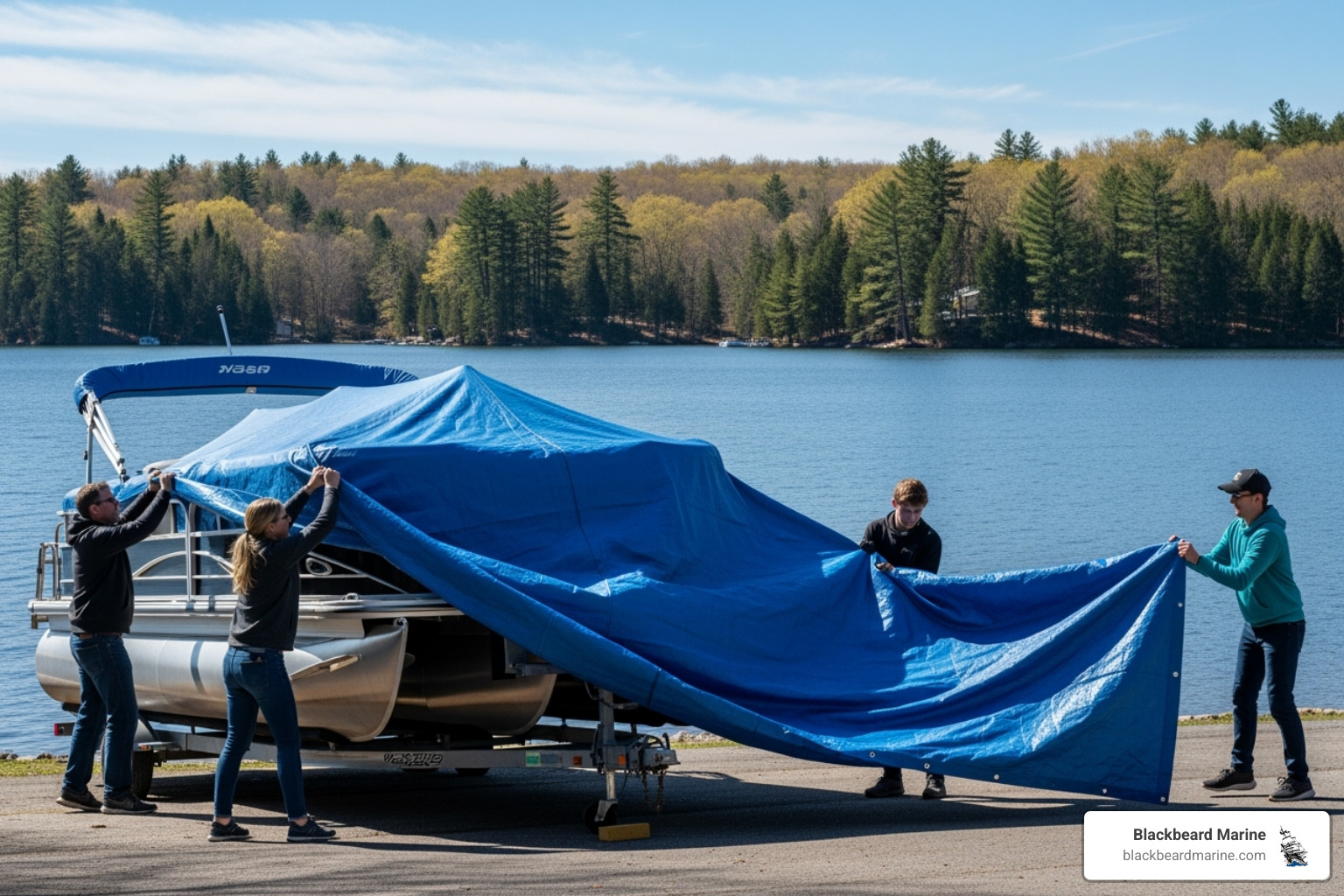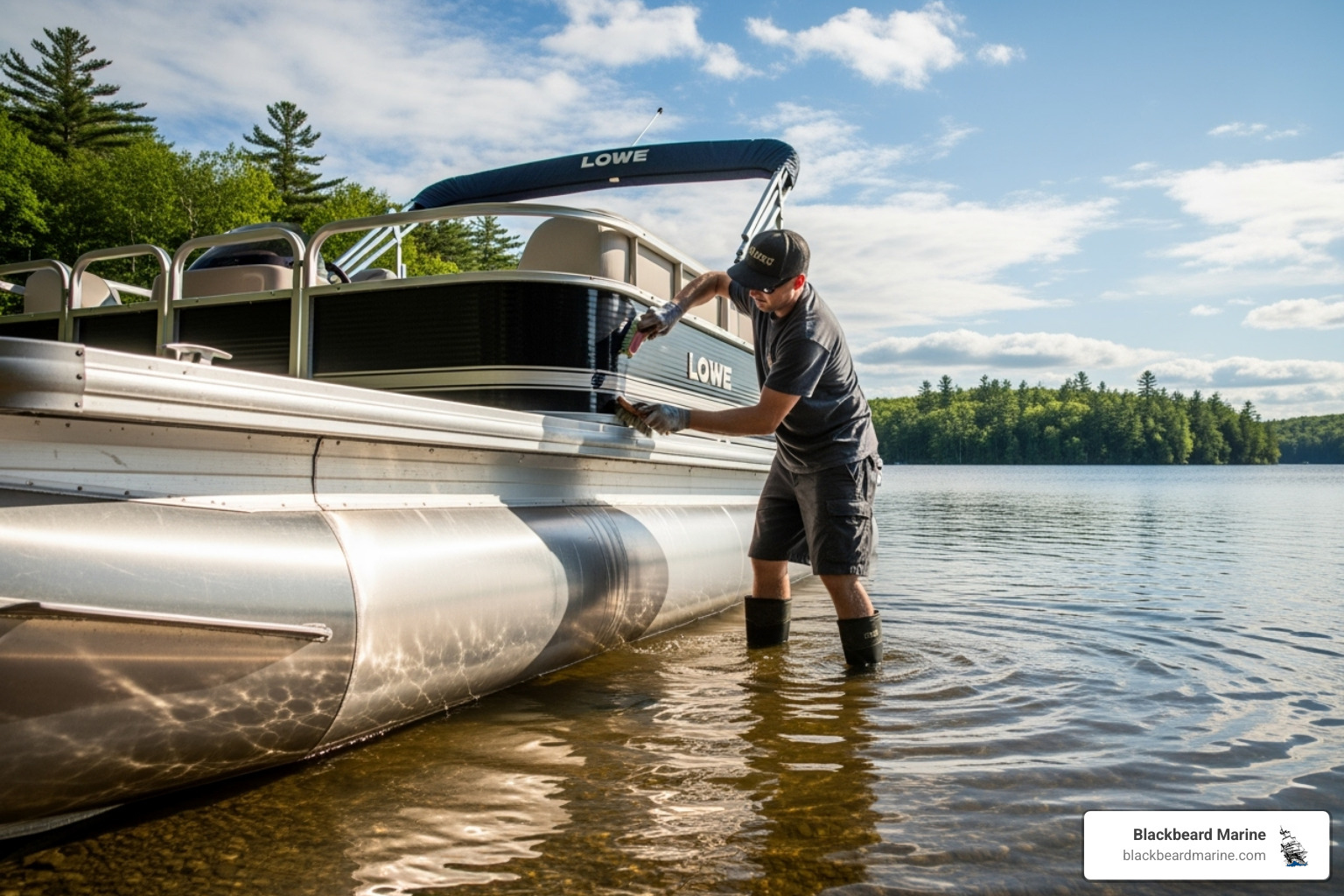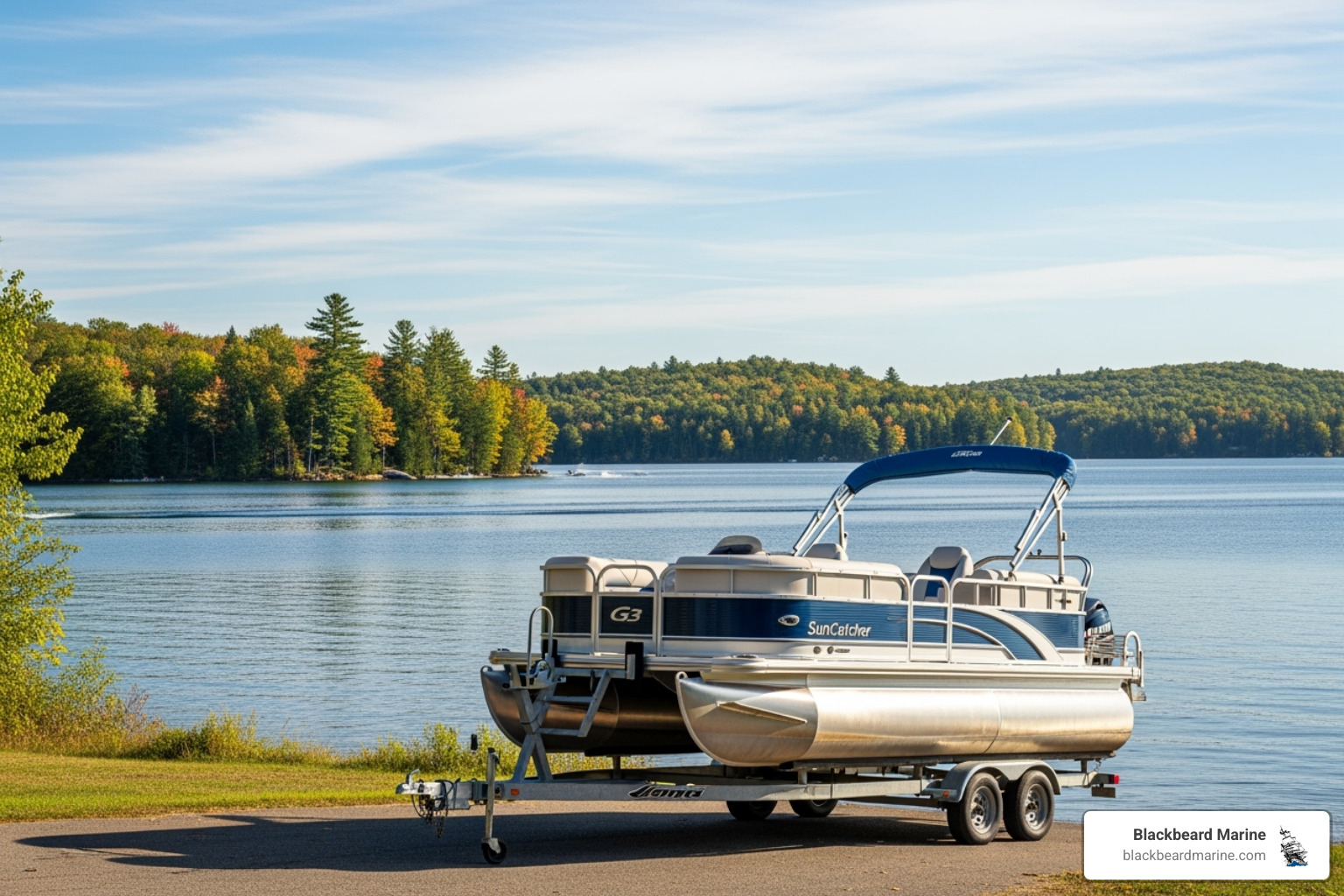Why Pontoon Boat Maintenance Tips Matter for Your Investment
Pontoon boat maintenance tips are essential for protecting your investment and ensuring safe, reliable performance on the water. Regular upkeep prevents costly repairs, extends your boat’s lifespan, and keeps your family safe during every outing.
Quick Reference: Essential Pontoon Boat Maintenance Tasks
- Spring: De-winterize engine, check battery, inspect safety gear, test all systems
- During Season: Rinse after every use, wash monthly, flush motor, inspect pontoons
- Fall: Add fuel stabilizer, fog engine, drain water systems, clean thoroughly, cover properly
- Year-Round: Check electrical connections, inspect upholstery, maintain trailer components
- After Saltwater Use: Rinse entire boat immediately, flush engine with fresh water
Your pontoon isn’t just a boat—it’s where your family creates memories on Lake Texoma and Table Rock Lake. Whether you own a Suncatcher, G3, or Lowe pontoon, proper maintenance means more time enjoying the water and less time dealing with repairs.
The good news is that most pontoon maintenance is straightforward. As one boat manufacturer puts it: “Maintaining your pontoon boat may seem intimidating but remember this: prevention is key.”
This guide covers the exact steps to keep your pontoon running smoothly, from seasonal prep to weekly upkeep.

Pontoon boat maintenance tips vocab explained:
Seasonal Bookends: Spring Launch & Winter Storage
Properly preparing your boat for winter and de-winterizing it in spring is the difference between a smooth season and one filled with expensive repairs. These seasonal transitions are where pontoon boat maintenance tips matter most. Get them right, and your Suncatcher, G3, or Lowe pontoon will reward you with years of reliable performance on Lake Texoma and Table Rock Lake.
Spring De-Winterization Checklist
After sitting idle, your pontoon needs a thorough de-winterization to catch small issues before they become big problems.

- Uncover and Clean: Start by uncovering your boat and clearing away winter debris like leaves and dirt.
- Systems Check: Test navigation lights, the horn, and all electronics.
- Battery: Reconnect your battery terminals, clean off any corrosion with a wire brush, and check its charge. A fully charged marine battery should read 12-12.5 volts. If it sat without a trickle charger, it will likely need a full recharge.
- Engine De-winterization: This is a critical step. While you can follow your manufacturer’s checklist, our service team at Blackbeard Marine can handle it for you to ensure it’s done right.
- Fuel System: Check for leaks or damage. If you used a stabilizer last fall, your fuel should be in good shape. Run the engine briefly to circulate fresh fuel.
- Safety Gear: Perform a safety gear inspection. Ensure your fire extinguisher is charged and accessible. Inspect life jackets for damage and confirm you have enough for all passengers.
- General Inspection: Do a walk-around. Check the Bimini top for mildew or damage. Apply a protectant spray to vinyl, plastic, and rubber surfaces. Clean windows and mirrors with a non-ammonia cleaner.
- Trailer: Inspect your trailer. Lubricate wheel bearings, the winch, and tongue jack. Check tire pressure, tread, brakes, safety chains, and lights to ensure a safe trip to the water.
For more detailed guidance on spring prep, explore the U.S. Coast Guard Recreational Boating Safety resources.
Winterization: Protecting Your Pontoon from the Elements
When fall arrives in Oklahoma and Missouri, proper winterization is crucial. It prevents damage from freezing temperatures and saves you from major headaches in the spring.
- Fuel System: Add marine-grade fuel stabilizer to your tank and run the engine for 10-15 minutes to circulate it. Then, top off the tank to minimize condensation.
- Engine Fogging: Protect your motor’s internal components from corrosion by applying fogging oil according to the manufacturer’s instructions.
- Drain Water Systems: This is absolutely critical. Drain the engine block, freshwater systems, livewells, and washdowns. Use marine antifreeze as needed to prevent any freeze damage in water passages.
- Thorough Cleaning: Give your pontoon a deep clean. Remove all dirt, grime, and mildew, as stains set over winter. Clean, condition, and apply a UV protectant to all vinyl upholstery. If possible, store cushions indoors.
- Proper Covering: Professional shrink-wrapping offers the best protection. A custom-fit winter cover also works well. Standard mooring covers are not sufficient for harsh weather.
- Motor Position: Crucially, store your outboard motor in the full down position. This allows any residual water to drain completely, preventing it from freezing and cracking expensive components.
- Battery and Valuables: Remove valuables, electronics, and your battery. Store the fully charged battery in a cool, dry place on a trickle charger.
Essential Winterization Supplies:
- Marine-grade fuel stabilizer
- Engine fogging oil
- Marine antifreeze
- Engine flush kit
- Boat cleaner and protectants
- Mildew remover
- High-quality boat cover or shrink-wrap
- Battery tender/trickle charger
These seasonal bookends protect your investment and ensure your Suncatcher, G3, or Lowe pontoon stays ready for action year after year.
The Ultimate List of Pontoon Boat Maintenance Tips
Routine care keeps your Suncatcher, G3, or Lowe pontoon performing its best and prevents major overhauls. Here are the specifics for each component.

Pontoons, Deck, and Exterior Care
Your pontoon’s exterior is its armor; keeping it in shape is essential.
Start with a regular pontoon inspection for dents or damage. If your boat sits low or lists to one side, you may have water in a tube. This extra weight hurts performance, strains the engine, and increases fuel use. Most pontoons have drain plugs, but you’ll need to lift the boat to use them. If you suspect a leak, seek professional welding immediately.
Aluminum cleaning prevents oxidation. Use a specialized cleaner to brighten and protect the tubes, but only after removing all surface debris first. Waxing and polishing every few months protects against sun, salt, and debris. For fiberglass surfaces, polishing locks in the protective wax coating.
Don’t forget UV protection. The Oklahoma sun is harsh, so apply UV protectants to all exposed plastic, rubber, and vinyl surfaces to prevent fading and cracking. Finally, keep your deck clean with a non-skid cleaning solution to prevent slippery and dangerous surfaces.
For more detailed tips on caring for your pontoon’s structure, consult your Suncatcher, G3, or Lowe owner’s manual and follow manufacturer-recommended cleaners and protectants.
Interior, Upholstery, and Canvas Cleaning
A clean interior makes every cruise on Table Rock Lake or Lake Texoma more enjoyable.
Vinyl seat cleaning requires a marine-grade cleaner to avoid damage. Combat mildew, common in our humid summers, with a specialized remover. Always finish with a UV protectant spray to prevent sun damage and inhibit future mildew growth. While cleaning, inspect the stitching on your upholstery for small tears or loose threads.
Clean your Bimini top canvas regularly with a soft brush and mild soap. If water stops beading, it’s time to re-waterproof it. For windows and mirrors, use a non-ammonia cleaner to avoid damaging tints or plastics. For flooring, vacuum marine carpet regularly and use a marine carpet cleaner for stains. Vinyl flooring just needs a good scrub with a mild boat cleaner.
Electrical System and Battery Health
Electrical issues can ruin a day on the water. Regular checks are vital.
Perform a regular battery inspection. Look for damage or leaks. A healthy, fully charged battery should read 12-12.5 volts at rest and 13-14.5 volts when the engine is running. Terminal cleaning prevents most electrical issues. Use a wire brush to remove corrosion and ensure connections are snug.
When storing your pontoon, use a trickle charger to maintain your batteries and extend their life. Know where your fuse panel is and keep spares on hand. Inspect wiring for cuts, wear, or chafe. Exposed wiring can cause short circuits. For any complex electrical issues, visit one of our Blackbeard Marine service centers.
Before every outing, test your navigation lights. This simple safety check keeps you safe and legal on the water.
Mastering Your Motor and Trailer
Your motor and trailer require meticulous care for smooth, reliable boating adventures.

Essential Outboard Motor Maintenance Tips
The outboard motors on Suncatcher, G3, and Lowe pontoons require regular attention for maximum reliability.
For a new pontoon, the engine’s break-in period is critical for longevity. It involves running the engine at varied RPMs for specific durations to properly seat internal components. Always follow your owner’s manual precisely; skipping this one-time process can reduce engine life and long-term performance.
Before every trip, perform quick checks: check the engine oil level, ensure you have enough fuel (plus a reserve), and give the propeller a quick inspection for dings or tangled fishing line.
After each trip, flush your motor with fresh water. This simple step removes salt and corrosive elements from internal components.
Routine maintenance is recommended annually or every 100 hours. This includes an oil and filter change and a fuel filter replacement. More in-depth service at 300 hours includes checking the water pump impeller and spark plugs. For these services, we recommend having our expert service team at Blackbeard Marine handle the work.
For more comprehensive motor care guidance, consult your Suncatcher, G3, or Lowe owner’s manual, or speak with our Blackbeard Marine service team.
Don’t Forget the Trailer
Trailer neglect can lead to dangerous roadside breakdowns. Regular maintenance is essential for safely transporting your pontoon.
Before every tow, check your tire pressure and inspect for tread wear, cracks, or bulges. Don’t forget the spare. Wheel bearings need regular lubrication according to your trailer’s manual to prevent failure.
Before each trip, test your trailer brakes and all lights. Inspect your winch for proper operation and check the strap for damage. Ensure the tongue jack is lubricated and operates smoothly. Finally, ensure your safety chains are securely attached and in good condition.
Proper trailer maintenance ensures a hassle-free journey to your favorite lake in Oklahoma or Missouri.
Special Considerations for Oklahoma and Missouri Boating
Boating on Lake Texoma and Table Rock Lake has unique challenges. Tailor your pontoon boat maintenance tips to these specific environments.
In-Season vs. Off-Season Storage
How you store your Suncatcher, G3, or Lowe pontoon makes a tremendous difference in its longevity.
During the season, a quality mooring cover is essential. It protects your pontoon from sun, rain, and debris. A boat lift on Table Rock Lake is a major advantage, as keeping the pontoon out of the water minimizes algae growth, staining, and UV exposure.
For off-season storage, your choice of cover is as important as winterization prep. Indoor storage is ideal. Otherwise, use professional shrink-wrapping or a high-quality, ventilated custom winter cover for protection against the elements.
Don’t forget about critter prevention during storage. Block exhaust ports and air intakes with steel wool. A few mothballs or dryer sheets can also help discourage unwanted guests.
Freshwater vs. Brackish Water Pontoon Boat Maintenance Tips
The water you boat in dramatically affects your maintenance routine.
Freshwater environments like Table Rock Lake are gentler, but regular washing is still needed to remove algae and pollutants. A key concern is preventing the spread of invasive species; always inspect your boat and trailer for hitchhikers like zebra mussels before moving between lakes.
Lake Texoma can have brackish water (a mix of fresh and salt), which significantly accelerates corrosion. If you’re boating in these areas, follow these steps:
- Flush your engine with fresh water immediately after every use. This is essential to prevent salt from corroding internal components. Use the motor’s flush port to run fresh water through the system for 10-15 minutes.
- Thoroughly rinse your entire pontoon, including the trailer, with fresh water. This stops the corrosive effects of salt on all surfaces and fittings.
- Check your sacrificial anodes monthly. These zinc or aluminum parts are designed to corrode instead of your boat’s critical components. Replace them when they are about 50% depleted.
The bottom line? Understanding your local conditions—whether you’re in Branson or on Lake Texoma—helps you protect your Suncatcher, G3, or Lowe pontoon.
For more insights into preventing invasive species in our region, visit Stop Aquatic Hitchhikers.
Frequently Asked Questions about Pontoon Care
After years of helping Suncatcher, G3, and Lowe pontoon owners at Blackbeard Marine, we’ve noticed the same questions come up again and again.
How often should I wash my pontoon boat?
Rinse your pontoon after every use, especially in Lake Texoma’s brackish water. Plan a thorough wash with marine-safe soap once a month during the season. This prevents contaminants from baking into the surfaces under the Oklahoma sun, causing stubborn stains. Focus on the waterline and the pontoons to prevent scum and algae buildup.
What are the signs of water inside a pontoon tube?
The main signs are your boat sitting lower in the water, listing (tilting) to one side, or a sloshing sound from the tubes. Water inside a pontoon adds significant weight, leading to reduced performance, poor fuel economy, and extra strain on your engine. If you spot these signs, contact our service team at Blackbeard Marine for professional leak detection and welding repair.
What is the most important part of a new motor’s break-in period?
The most critical part of a new motor’s break-in is varying the RPMs and avoiding sustained full throttle. This allows the engine’s internal components to seat properly. Following your owner’s manual precisely during this period is essential for the motor’s longevity and performance. Rushing this process can lead to future performance issues. When it comes to pontoon boat maintenance tips, proper break-in is a crucial time investment that pays dividends for the life of your boat.
Keep Your Pontoon Ready for the Water
We’ve journeyed through quite a bit together—from spring de-winterization checklists to winterization must-dos, from cleaning aluminum pontoons to breaking in new motors. If there’s one thing to remember from all these pontoon boat maintenance tips, it’s this: a little regular care goes a long way.
Think of maintenance as your ticket to more weekends on Lake Texoma, more sunset cruises on Table Rock Lake, and more spontaneous afternoon trips when the weather’s just right. When your Suncatcher, G3, or Lowe pontoon is well-maintained, it’s always ready to go—no last-minute surprises, no unexpected breakdowns that eat into your precious lake time.
The beauty of pontoon maintenance is that most of it isn’t complicated. Rinse after use. Check your battery terminals. Keep things clean. These simple habits add up to years of reliable performance and countless family memories. Your pontoon isn’t just a boat—it’s your floating living room, your fishing platform, your sunset-watching spot.
Of course, we understand that life gets busy. Maybe you don’t have time for that 100-hour service, or perhaps you’d rather leave the winterization to the experts. That’s exactly what we’re here for at Blackbeard Marine. Our service centers are staffed with experienced technicians who know these boats inside and out. We’re here to handle everything from routine oil changes to complex engine work, so you can focus on what matters most: enjoying the water.
Whether you’re a seasoned boat owner looking for your next upgrade or just starting your pontoon journey, we’d love to help you find the perfect boat for your family.
Here’s to smooth sailing, clear skies, and a pontoon that’s always ready when you are!
